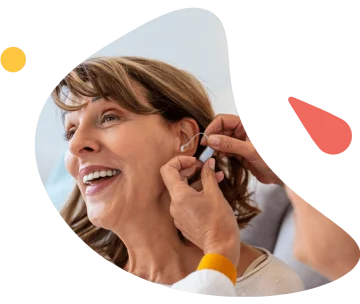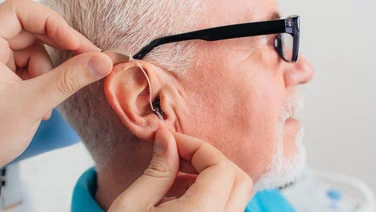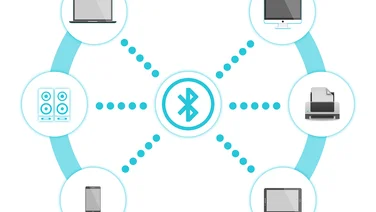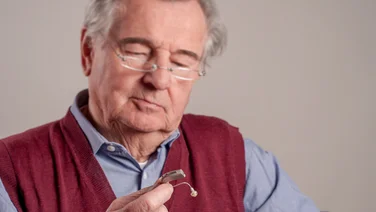Depending on what type and the degree of hearing loss you have, you may benefit from an in-the-ear (ITE) hearing aid.
These are less obvious than the traditional aids that hook over the top of your ear, which are called behind-the-ear hearing aids.
There are different styles of ITE aids, including invisible hearing aids.
We explain how ITE hearing aids work, their advantages and drawbacks, and who might benefit from wearing one.
If you are experiencing hearing loss and think a hearing aid might help, talk to your audiologist about the type of hearing aid that is best for you.
Experiencing hearing loss and think a hearing aid might help?
Talk to an audiologist and see if an ITE hearing aid is right for you
How do in-the-ear (ITE) hearing aids work?
All hearing aids are made up of three main components: a microphone, an amplifier, and a speaker (also called a receiver).
With a traditional behind-the-ear hearing aid, the microphone and amplifier are contained in a small, plastic case that hooks over and rests behind the ear. The receiver sits in an earmold in the bowl of the ear, or a domed tip that’s inserted into the ear canal.
With an ITE hearing aid, there is no external casing that hooks around the top of your ear. Instead, all of the components of the hearing aid are enclosed in a small shell that sits completely in the outer ear.

The microphone picks up sounds from the environment and converts them into electrical signals, which are made louder by the amplifier and carried through a speaker (also called a receiver) further into the ear.
Depending on the style of ITE hearing aid, the shell may fit in the bowl of your ear or, alternatively, it may sit inside your ear canal.
The difference between the styles of ITE hearing aids are their size, and how much of the hearing aid you can see when you wear it. You can even get hearing aids that are invisible, which are called invisible in the canal hearing aids.
Full shell and half shell hearing aids
A full shell hearing aid contains the electronic elements in a plastic shell that’s custom-made to fit the conchal bowl – also called the concha or bowl – of your outer ear.
A similar type, called a half shell hearing aid, is smaller and sits at the entrance to the ear canal so it’s less noticeable. Again, this type is custom-made to fit your ear.
You can use these hearing aids for mild to severe hearing loss.
- They are big enough that they can come with useful features, like bluetooth connectivity and volume controls
- Unlike smaller hearing aids, you may be able to operate them if you have some dexterity impairment
- They can be made in colors to match your skin tone, making them less noticeable
- They can include directional microphones, which help you to hear better in noisy environments
- Their size means they can use a larger battery than smaller hearing aids, including rechargeable batteries
- Even with skin-colored, sleek designs they are noticeable
- Because of their position in the ear, you might feel like your ears are clogged up
- They can become blocked with ear wax interfering with the receiver
- They can pick up background noise, like wind, more than smaller hearing aids
In the canal (ITC) hearing aids
An in the canal (ITC) hearing aid is similar to half shell ITE aids, but is another step down in hearing aid size. The custom-made shell is smaller and is positioned in the entrance to the ear canal, but it is not pushed deep inside it. The pros and cons include:
- It has many of the same benefits of ITE hearing aids, but is less visible
- Like full and half shell aids, they include some useful features that cannot fit onto smaller hearing aids, like volume control
- Because of its small size, it may be difficult to adjust features like volume control if you have dexterity problems
- The receiver is vulnerable to getting clogged up with ear wax and moisture
- It may be too small to include bluetooth connectivity
Completely in the canal (CIC) and invisible in canal (IIC) hearing aids
You can see in the image below, as technology advances, hearing aids are getting smaller. These days, many people with hearing loss want the smallest devices possible and, in some cases, hearing aids that are ‘invisible’.

The two smallest hearing aids on the market are the completely in the canal (CIC) and invisible in the canal (IIC) hearing aids.
CIC hearing aids are similar to ITC hearing aids, but the tiny aid that houses all of the components sits deeper in your ear canal. Like ITC aids, they are custom-made to fit you. They are unobtrusive and barely noticeable.
The very smallest hearing aids are invisible in the canal (IIC) hearing aids.
As the name suggests, these tiny, discreet hearing aids sit deeper in the ear canal and cannot be seen by onlookers. Invisible hearing aids are increasingly popular for this reason.
The difference between CIC and IIC hearing aids is how deep they sit in your ear canal, with invisible in the canal hearing aids sitting further inside your ear canal.
To remove in the canal and invisible hearing aids, you pull on a small string that’s attached to the hearing aid.
There are several benefits to using invisible hearing aids. Many people like the idea of them because they are hidden, and they don’t want to wear a bulky device that everyone can see.
In addition, CIC and IIC hearing aids are less likely to pick up background sounds, including wind noise.
However, they are not always the best solution for hearing loss.
- Because they are so small, most CIC and invisible hearing aids don’t come with the same features as other types of hearing aids, like Bluetooth connectivity, volume control, or directional microphones
- They have small batteries, which means they typically have a shorter life and need to be replaced frequently
- Their size can be problematic if you have dexterity problems or impaired vision
- Sitting deep inside the ear canal, these hearing aids can become clogged up with earwax and they are also susceptible to moisture
CIC and invisible hearing aids are suitable if you have mild or moderate hearing loss, but they won’t provide any benefit if you have severe or profound hearing loss.
- Many people like the idea of them because they are hidden, and they don’t want to wear a bulky device that everyone can see.
- CIC and IIC hearing aids are less likely to pick up background sounds, including wind noise.
- * Because they are so small, most CIC and invisible hearing aids don’t come with the same features as other types of hearing aids, like bluetooth connectivity, volume control, and directional microphones
- * They also have very small batteries, which means they typically have a shorter life and need replacing more frequently
- Their size can be problematic if you have dexterity problems or impaired vision
- Sitting deep inside the ear canal, these hearing aids are very susceptible to moisture and ear wax clogging them up
How much do in-the-ear hearing aids cost?
Costs of in-the-ear hearing aids – including invisible hearing aids – will vary between providers and depend on many different factors.
If you want to find out if you would benefit from an ITE hearing aid, a CIC hearing aid, or an invisible hearing aid, speak to your audiologist. They will discuss the options with you and advise which hearing aid type is best for you.
Book a hearing consultation for free today








